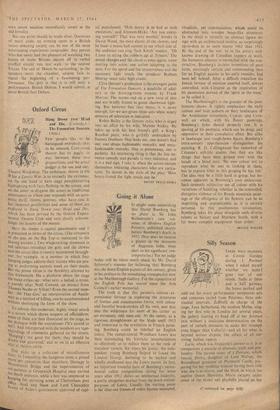Going it Alone
The truth is that this painter's intense ex- pressionist fervour in exploring the structures of human and mountainous forms, with colour and forceful brush-strokes all his own, sent him into the wilderness for most of his career as an extremely odd man out. At the outset, as a rigorous draughtsman at the Slade until 1913 and immersed in the revolution in French paint- ing, Bomberg could be labelled an English cubist. The conspiratorial Wyndham Lewis' was then dominating his Vorticist insurrectionists so effectively as to reduce them to the rank of truculent vassals. Six years his junior, the inde- pendent young Bomberg helped to found the London Group, declining to be sucked and wholly swallowed into the Lewis vortex. In fact, an important roomful here of Bomberg's monu- mental cubist compositions dating for some years after 1912 shows an intellectual austerity, a purity altogether distinct from the mock-sinister purposes of Lewis. Usually the starting point is the clear-cut frames of robot figures. animated, ritualistic, yet expressionless, which could he abstracted into wooden beam-like structures. In the Hold is virtually an abstract jigsaw de- sign with an architectural motive, so surprisingly up-to-date as to seem nearer 1963 than 1913. By the end of the war, as in the artist's well- known drawing of Canadian sappers at work, the humanist element is reconciled with the con- structive. Bomberg's incisive inventions of pure form, amazingly certain and commanding then for an English painter in his early twenties, had been left behind. After a difficult transition his Jewish fervour of emotion asserted itself, always controlled, with Cezanne as the inspiration of his passionate pursuit of the 'spirit in the mass,' as he called it.
The Marlborough's is the grander of the post- humous shows. It rightly emphasises the early cubism and later auburn or fiery landscapes of the Andalusian mountains, Cyprus, and Corn- wall on which, with his flower paintings, Bomberg's fame should properly rest. It is sparing of his portraits, which can be dingy and oppressive in their cumulative effect. But alike in landscape and rough-hewn figure, Bomberg's extra-sensory apprehension distinguishes his painting. R. G. Collingwood has remarked of Cezanne's still-life studies that they are like things that have been groped over with the hands of a blind man. 'He uses colour not to reproduce what he sees in looking at them, but to express what in this groping he has felt.' The idea may be a little hard to grasp, but be- comes apparent in Bomberg's own endeavour. Such intensely subjective use of colour with his variations of handling, whether in the controlled, disruptive violence of his Ronda mountain paint- ings or the effulgence of his flowers, can be as inspiriting and unpredictable as it is entirely personal. In this posthumous revaluation, Bamberg takes his place alongside such diverse talents as Sicken and Matthew Smith, Oith a far more complex equipment than either.
NEV ILE WALLIS


































 Previous page
Previous page